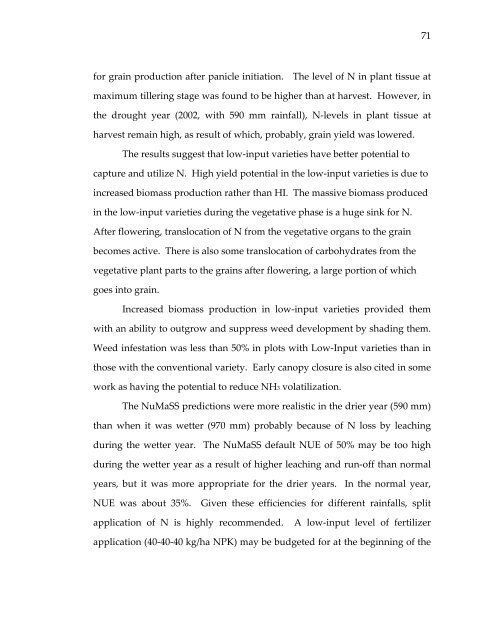Management of rice production systems to increase productivity
Management of rice production systems to increase productivity
Management of rice production systems to increase productivity
Create successful ePaper yourself
Turn your PDF publications into a flip-book with our unique Google optimized e-Paper software.
for grain <strong>production</strong> after panicle initiation. The level <strong>of</strong> N in plant tissue at<br />
maximum tillering stage was found <strong>to</strong> be higher than at harvest. However, in<br />
the drought year (2002, with 590 mm rainfall), N‐levels in plant tissue at<br />
harvest remain high, as result <strong>of</strong> which, probably, grain yield was lowered.<br />
The results suggest that low‐input varieties have better potential <strong>to</strong><br />
capture and utilize N. High yield potential in the low‐input varieties is due <strong>to</strong><br />
<strong>increase</strong>d biomass <strong>production</strong> rather than HI. The massive biomass produced<br />
in the low‐input varieties during the vegetative phase is a huge sink for N.<br />
After flowering, translocation <strong>of</strong> N from the vegetative organs <strong>to</strong> the grain<br />
becomes active. There is also some translocation <strong>of</strong> carbohydrates from the<br />
vegetative plant parts <strong>to</strong> the grains after flowering, a large portion <strong>of</strong> which<br />
goes in<strong>to</strong> grain.<br />
Increased biomass <strong>production</strong> in low‐input varieties provided them<br />
with an ability <strong>to</strong> outgrow and suppress weed development by shading them.<br />
Weed infestation was less than 50% in plots with Low‐Input varieties than in<br />
those with the conventional variety. Early canopy closure is also cited in some<br />
work as having the potential <strong>to</strong> reduce NH3 volatilization.<br />
The NuMaSS predictions were more realistic in the drier year (590 mm)<br />
than when it was wetter (970 mm) probably because <strong>of</strong> N loss by leaching<br />
during the wetter year. The NuMaSS default NUE <strong>of</strong> 50% may be <strong>to</strong>o high<br />
during the wetter year as a result <strong>of</strong> higher leaching and run‐<strong>of</strong>f than normal<br />
years, but it was more appropriate for the drier years. In the normal year,<br />
NUE was about 35%. Given these efficiencies for different rainfalls, split<br />
application <strong>of</strong> N is highly recommended. A low‐input level <strong>of</strong> fertilizer<br />
application (40‐40‐40 kg/ha NPK) may be budgeted for at the beginning <strong>of</strong> the<br />
71
















